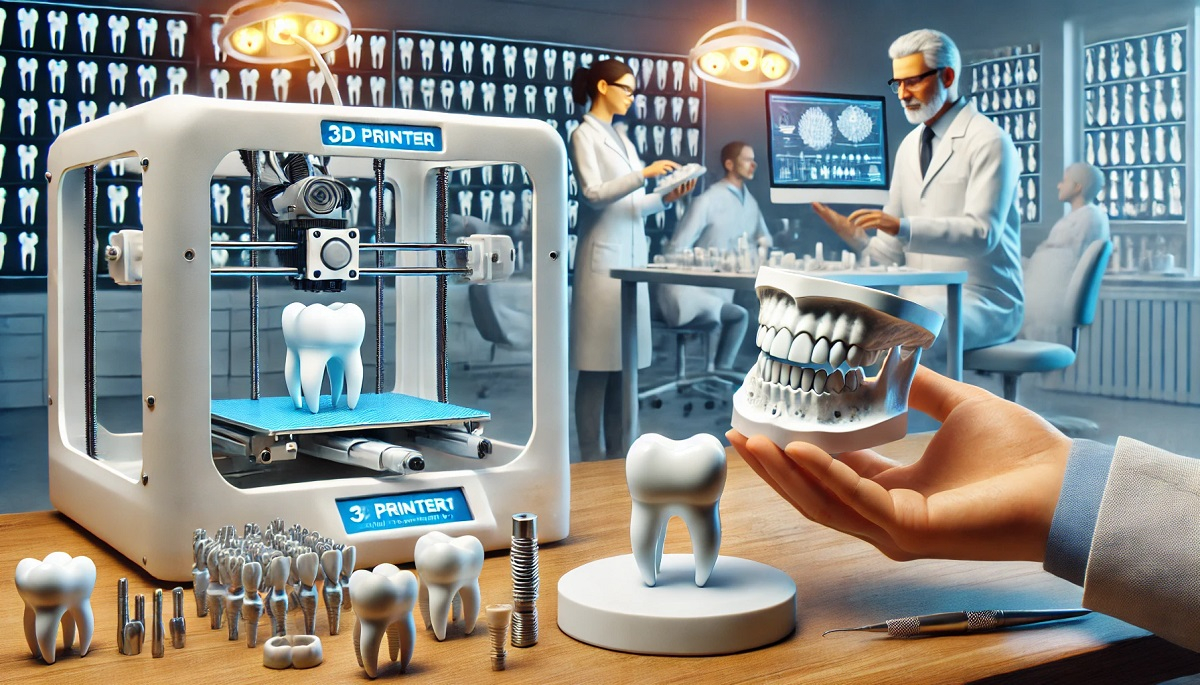Dental 3D Printing Market Size and Growth Analysis
The Dental 3D Printing Market report by MarketDigits provides a comprehensive analysis of the market trends from 2024 to 2032, covering various technologies, materials (metals, photopolymer, ceramics, and others), applications, and end-user segments. The study highlights key customer and partner ecosystems, examining product services, propositions, and distinguishing features.
The competitive index and regional footprints are also assessed, offering insights into how players in the dental 3D printing industry are positioning themselves across different regions. The forecasted growth and strategic opportunities in the dental sector are integral to understanding market dynamics and driving innovation.
The Dental 3D Printing Market is estimated to be valued at USD 17.3 billion in 2024 and is expected to grow to USD 21.1 billion by 2030, with a compound annual growth rate (CAGR) of 2.9% throughout the forecast period from 2024 to 2032.
Get the Sample Research Report Copy on Dental 3D Printing Market: https://www.marketdigits.com/request/sample/287
Reasons behind the Increased Demand for Dental 3D Printing in Recent Years
Advancements in 3D Printing Technology: Recent technological advancements in dental 3D printing have greatly enhanced the precision, efficiency, and speed of producing dental restorations. These innovations enable the creation of complex dental structures with greater accuracy, which has led to a significant increase in adoption by dental professionals seeking high-quality, reliable solutions. The improvements in 3D printing technology have made it easier to design and produce custom dental appliances, further driving the market growth.
Customization and Patient-Specific Solutions: The growing demand for personalized dental solutions has contributed significantly to the rise of 3D printing in dentistry. With the ability to create custom crowns, bridges, implants, and orthodontic devices, dental 3D printing offers patient-specific solutions that improve comfort and treatment outcomes. The shift toward customization has played a key role in increasing the adoption of this technology in dental practices, as it enables healthcare providers to deliver more accurate and tailored treatments for individual patients.
Cost Efficiency and Time Reduction: Dental 3D printing is recognized for its ability to streamline the production process, reducing both lead times and material waste. This not only lowers operational costs but also allows for faster turnaround times, which is crucial for improving the patient experience. According to recent surveys, nearly 47% of dental professionals cite the reduction in lead time as a key factor for choosing 3D printing over traditional manufacturing methods, highlighting the economic and time-saving benefits of this technology.
Increasing Prevalence of Dental Disorders: The rising incidence of dental issues, such as tooth loss, decay, and other oral health problems, has increased the demand for restorative dental procedures. Dental 3D printing plays a crucial role in addressing these issues by providing cost-effective and efficient solutions for creating implants, crowns, bridges, and other dental prosthetics. As dental conditions continue to affect a large portion of the population, the need for innovative dental treatments powered by 3D printing technologies is expected to rise.
Projected Increase in Demand for Dental 3D Printing
Growing Aging Population: As the global population ages, the demand for dental restorations, such as implants and prosthetics, is set to rise significantly. With a higher number of older adults experiencing tooth loss and other dental conditions, the need for customized dental solutions will continue to expand. According to the American College of Prosthodontics, over 36 million Americans are completely edentulous, and 120 million are missing at least one tooth, underscoring the growing market for dental 3D printing technologies that can address these challenges.
Expansion of Dental Applications: The versatility of dental 3D printing, which is applicable in orthodontics, prosthodontics, and implantology, is another major factor contributing to its increasing demand. As the range of applications for dental 3D printing continues to expand, the technology is being increasingly integrated into various aspects of dental treatment.
Technological Integration and Digitalization: The integration of 3D printing with other digital dentistry tools, such as CAD/CAM systems and intraoral scanners, is expected to revolutionize dental workflows. This technological synergy enhances workflow efficiency, accuracy, and precision in creating dental restorations. As dental professionals continue to embrace digital dentistry, the demand for 3D printing solutions is anticipated to increase, driving continued market growth in the years to come.
Top Players in Dental 3D Printing Market | Expansions, Agreements, Partnerships, and Research & Development (R&D) Initiatives
EnvisionTEC, Inc.: In early 2024, EnvisionTEC entered into a strategic partnership with 3D Systems, combining their advanced 3D printing technologies. This collaboration aims to enhance the production of dental implants and prosthetics, leveraging 3D Systems' expertise in additive manufacturing and EnvisionTEC's specialization in dental applications. The partnership is expected to offer more efficient, customizable solutions to dental professionals, meeting the increasing demand for high-quality dental products.
3D Systems, Inc.: In mid-2024, 3D Systems expanded its footprint in the dental sector through the acquisition of a leading dental 3D printing company. This acquisition strengthened 3D Systems' portfolio, allowing them to offer a broader range of dental solutions, including advanced materials and software tailored to the growing demand for customized dental products. This strategic move solidifies 3D Systems' position as a key player in the dental 3D printing market.
Renishaw plc.: Renishaw has made significant strides in research and development, particularly in 2024, by investing heavily in the development of new metal alloys for dental applications. These innovations aim to improve the strength and biocompatibility of dental implants, addressing the rising demand for durable, reliable dental solutions. The company's commitment to R&D continues to position it as a leader in dental 3D printing technologies.
SLM Solutions: In late 2024, SLM Solutions formed a strategic partnership with a prominent dental implant manufacturer to co-develop advanced metal 3D printing solutions for the dental sector. This collaboration focuses on improving the production efficiency and quality of dental implants, using SLM Solutions' expertise in metal additive manufacturing. By enhancing implant manufacturing, this partnership aims to meet the growing needs of the dental industry.
Formlabs, Inc.: Formlabs introduced a new 3D printer in early 2025, specifically designed for dental laboratories. This advanced printer features optimized resin materials and software, offering dental professionals a cost-effective and efficient solution for producing high-quality dental models and prosthetics. The introduction of this product is expected to further accelerate the adoption of 3D printing technology in dental practices, meeting the increasing demand for customized dental devices.
Stratasys Ltd.: In mid-2024, Stratasys expanded its dental materials portfolio by introducing new photopolymer resins tailored for orthodontic applications. These materials provide enhanced mechanical properties and biocompatibility, meeting the growing demand for customized orthodontic devices. This expansion strengthens Stratasys' presence in the dental sector, offering more versatile solutions for dental professionals.
DWS S.r.l.: In late 2024, DWS S.r.l. entered into a research collaboration with a renowned university to develop new ceramic materials for dental 3D printing. This initiative aims to improve the aesthetic and functional properties of dental restorations, providing dental professionals with more versatile material options for creating high-quality, patient-specific dental devices.
Prodways Group: In early 2024, Prodways Group acquired a dental 3D printing company specializing in high-resolution resin printers. This acquisition allowed Prodways to expand its product offerings and strengthen its presence in the dental market. By acquiring this company, Prodways aims to provide advanced 3D printing solutions that cater to the specific needs of dental professionals.
Get the complete view of 149 Pages Market Research Report on Dental 3D printing: https://www.marketdigits.com/dental-3d-printing-market
Top Innovations in 3D Printing and Their Impact on the Market
Recent developments in the dental industry have significantly advanced with the integration of 3D printing technology, offering revolutionary solutions for a variety of dental applications. Key innovations include 3D printed dentures, dental resin 3D printing, 3D printed teeth, and dental implants, all of which are reshaping the Dental 3D Printing Market and driving its rapid growth.
3D Printed Dentures: The advent of 3D printed dentures marks a significant leap forward in denture production. Using advanced 3D printing technologies, companies like Affordable Dentures & Implants have introduced FDA-approved digital dentures, such as the RealFit3D Denture, which combines precise computer-aided design with durable materials. This technology ensures a comfortable, natural-looking fit and a more accurate product compared to traditional dentures. The use of 3D printing in dentures has become a key factor in improving the speed and customization of dental care, which, in turn, has contributed to the expanding demand for 3D printing in dental applications.
Dental Resin 3D Printing: Dental resin 3D printing plays a pivotal role in producing highly accurate dental models and appliances. Companies such as Formlabs offer a wide range of specialized resins designed for dental applications, enabling the production of dental splints, surgical guides, fixed patterns, clear aligner models, and full dentures. These resins are carefully engineered to meet the specific needs of dental professionals, ensuring both high-quality and reliable results. The ability to print biocompatible and precision-driven products has boosted the growth of dental 3D printing, attracting more dental labs and practices to adopt these technologies for efficient and customized dental care.
3D Printed Teeth: The creation of 3D printed teeth is an emerging trend within the dental 3D printing market, although challenges such as material costs and the requirement for food-safe, non-toxic substances still exist. Despite these challenges, the potential for 3D printed teeth remains strong, as dental professionals continue to explore innovative ways to improve aesthetics, functionality, and durability. By offering a high degree of customization in the design and production of dental prosthetics, 3D printing allows for a more patient-centric approach in restoring lost teeth, which has led to greater adoption of this technology in the dental sector.
3D Printed Dental Implants: 3D printing technology has proven to be especially beneficial in the production of dental implants. By utilizing a variety of advanced materials such as titanium, stainless steel, and cobalt chromium, 3D printing enables the creation of highly customized dental implants. This customization allows for better-fitting implants that cater to the individual needs of patients, ensuring higher success rates and better long-term integration. The ability to control the porosity, size, and shape of dental implants enhances their functionality, which has made 3D printed dental implants a highly sought-after solution in restorative dentistry.
Get a Discount on the Premium Research Report on Dental 3D Printing Market: https://www.marketdigits.com/request/discount/287
Frequently Asked Questions about Dental 3D Printing Market
Is 3D Printing the Future of Dentistry?
Yes, 3D printing is set to play a crucial role in the future of dentistry. Advancements in 3D printing technologies enable the creation of highly precise dental restorations, including crowns, bridges, dentures, and orthodontic appliances. These innovations offer greater customization, efficiency, and enhanced patient outcomes, positioning 3D printing as an integral part of dental practices worldwide. As the technology evolves, it is expected to further revolutionize dental care.
How is 3D Printing Used in Dentistry?
3D printing is employed in various dental applications, improving both the speed and accuracy of treatments:
Crowns and Bridges: Custom crowns and bridges are fabricated using 3D printing, ensuring precise fits and reducing production times.
Dentures: 3D printing enhances the accuracy and comfort of dentures, leading to better-fitting prosthetics.
Orthodontic Appliances: Custom aligners and retainers, tailored to individual patients, are created with 3D printing, offering more comfortable and efficient treatments.
Surgical Guides: 3D-printed surgical guides help in the precise placement of dental implants, improving the success rates of dental surgeries.
Is 3D Printing Still Profitable in Dentistry?
Yes, 3D printing remains profitable in the dental industry. Early adopters of this technology have reported significant benefits, such as increased efficiency and reduced costs. By producing custom dental products in-house, practices can cut down on reliance on external laboratories, which leads to savings and faster turnaround times. Furthermore, the rising demand for personalized dental solutions contributes to the continued profitability of 3D printing in dentistry.
Are 3D Printed Teeth Good?
3D-printed teeth, especially for dentures, have shown promising results in terms of precision and fit. Studies indicate that 3D-printed teeth can achieve high levels of accuracy comparable to traditional methods. However, challenges remain, such as the hardness of resin materials and the accuracy of canal anatomy in 3D-printed teeth models. Ongoing research is addressing these issues to improve the longevity and functionality of 3D-printed dental restorations.
Other Trending Reports
Precision Medicine Software Market: https://www.marketdigits.com/precision-medicine-software-market-1705928498
Smart Wearable Medical Devices Market: https://www.marketdigits.com/smart-wearable-medical-devices-market-1705928498
Skin Analysis Technologies Market: https://www.marketdigits.com/skin-analysis-technologies-market-1706096798
Small Molecule Drug Discovery Market: https://www.marketdigits.com/small-molecule-drug-discovery-market-1706183989
CRISPR Gene Editing Market: https://www.marketdigits.com/crispr-gene-editing-market-1706601670
Leadless Pacemakers Market: https://www.marketdigits.com/leadless-pacemakers-market-1706601670
mRNA Vaccine Market: https://www.marketdigits.com/mrna-vaccine-market-1706601670
Research-grade Proteins Market: https://www.marketdigits.com/research-grade-proteins-market-1706601670
Stem Cells Market: https://www.marketdigits.com/stem-cells-market-1706615802
Complementary And Alternative Medicine Market: https://www.marketdigits.com/complementary-and-alternative-medicine-market-1706696894



